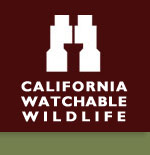

| Visitation: 4M annually | ||
| Area: 761,757 Acres | ||
| Lat: 37.8499 N | ||
| Lon: 119.5677 W | ||
| Nearby Services | ||
| Site Facilities | ||
| Join Our Mailing List |
|
For Email Marketing you can trust
|
Top Banner Photo Credits
Pam Starr
Alyn Robert Brereton
Julie MacKinnon
Linda Pittman
Parham Pourahmad
Larry Whiting
Randall Finley
Pam Starr
Alyn Robert Brereton
Julie MacKinnon
Linda Pittman
Parham Pourahmad
Larry Whiting
Randall Finley
© 2008-2024 California Watchable Wildlife and Blue Cat Studio, Inc.
| Yosemite National Park - Site # 214 | |||
| This world-famous park brims with outstanding scenery and habitat. Towering peaks, sheer cliffs, spectacular waterfalls, vast meadows, hundreds of lakes, crystal-clear streams, and giant sequoias form a pristine wilderness that shelters nearly 250 bird species, 80 mammal species, 29 types of reptiles and amphibians, and 1,400 species of flowering plants. Of these, peregrine falcons, great gray owls, wolverines, red fox, and California bighorn sheep are endangered. The park includes Tuolumne Meadows, the largest subalpine meadow complex in the world, as well as groves of ancient sequioas, some more than 2,500 years old. Most of the park is designated wilderness with 360 miles of paved roads and 800 miles of trails. | |||
 | Premium - the most significant sites, worth visiting if you have limited time. Premium sites have high wildlife values year-round, staff on site, interpretive programs and/or displays, and well-developed facilities. | ||
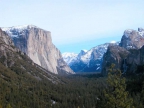
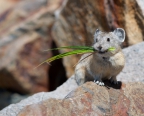
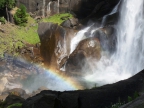

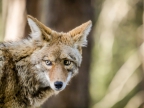
| |||
| Background: | For thousands of years, humans have changed this place we now call Yosemite. The Ahwahneechee lived here for generations, followed by the arrival of Europeans in the mid-1800s. The rugged terrain challenged many early European travelers, with just a few only 650 from the mid-1850s to mid-1860s making the journey to Yosemite Valley by horseback or stage. By 1907, construction of the Yosemite Valley Railroad from Merced to El Portal eased the journey, thereby, increasing visitation. Today, about 4 million people visit to explore Yosemite. | ||
| The name Yosemite itself is from the Indian word “uzumate,” which meant grizzly bear. The Indian tribe that lived in the Valley were called Yosemites by Caucasians and by other Indian tribes because they lived in a place where grizzly bears were common and they were reportedly skilled at killing the bears. The Mariposa Battalion named the Valley after the “Yosemite Indians” whom they’d been sent there to evict. The Indians didn’t call themselves Yosemites; they called themselves Ahwahneechees, and they called the Valley “Ahwahnee” or “place of a gaping mouth. Seven present-day tribes descend from the people who first called this area home. As Europeans arrived, violent disruption ensued that displaced the native populations. Early settlers arrived and hosted writers, artists, and photographers who spread the fame of "the Incomparable Valley" throughout the world. Park pioneers, like Galen Clark and John Muir, then spoke of Yosemite's need for protection, and that environmental philosophy was advocated by the scientists of the time and later enforced by the park's first nature guides. Early on, women helped make Yosemite what it has become--as influential concessioners, adventurers, and NPS employees who went beyond the time's traditional roles. | |||
| The Habitat: | The expansive park's 747,956 acres or 1,169 square miles, nearly 95 percent of which are designated Wilderness, are home to hundreds of wildlife species, and over a thousand plant species. Designated a World Heritage Site in 1984, Yosemite is known for its granite cliffs, waterfalls, clear streams, giant sequoia groves and biological diversity. Two Wild & Scenic Rivers, the Tuolumne and Merced rivers, begin in the park and flow west to the Central Valley. Visitors can explore 800 miles of hiking trails and 282 miles of scenic roadways. Moving up or down in elevation, you feel as though you are in another park. Vegetation changes from oak woodlands to chaparral scrublands to lower montane to upper montane to subalpine to alpine. Those who step into the alpine zone can see krummholz whitebark pines and perhaps a western juniper or mountain hemlock. Scientists study many individual plants, including the black oak, to understand its future challenges. | ||
| The Experience: | Yosemite supports more than 400 species of vertebrates, including fish, amphibians, reptiles, birds, and mammals. Insects abound as well, with the recent discovery of two species not believed to exist anywhere else in the world. The high diversity of animal species coincides with the striking elevational gradient and topographic variability of the park. | ||
| Wildlife and Where to Find It: | Look for golden-mantled ground squirrels, raccoons, coyotes, mule deer, golden eagles, band-tailed pigeons, Steller's jays, and acorn woodpeckers year-round. Western tanagers, black-headed grosbeaks, white-throated swifts, and other songbirds are seen in spring and summer. Black bears sometimes seen from spring through fall. Watch for peregrine falcons in Yosemite Valley. | ||
| Viewing Tips: | PARK IS EXTREMELY CROWDED BETWEEN MEMORIAL DAY AND LABOR DAY. Visitor center, tours. On the Pacific Crest Trail. | ||
| Nearby Viewing Sites: | Lee Vining Tioga Lake Pinecrest Lake Mono Basin National Forest Scenic Area Lake McClure | ||
| Festivals & Events: | Chefs' Holiday Bracebridge Dinner Vintners' Holiday | ||
| Visitor Information: | Yosemite Mariposa County Tourism Bureau - (209) 742-4567 - https://www.yosemite.com/ | ||
| Viewing Site Hours of Operation are: | |||
| Staff On-site: | Yes | ||
| Open: | Seven days a week | ||
| Hours: | Yosemite National Park is open 24 hours per day, 365 days per ye | ||
| Year Round: | Yes | ||
| Road Information: | |||
| Road Hazards: Roads may be closed during winter due to snow. Tioga Pass, Hwy. 120 is generally closed in winter and into spring. Check ahead for road closures. Always carry chains when traveling in higher elevations. | |||
| Parking Fee: Yes | |||
| Proximity to viewing area: | |||
| Parking Notes: There is a fee to enter the park. It varies depending on your age. Information about fees and passes is available online at: Click Here | |||
| How to Get There: | From Manteca and Interstate 5, take Highway 120 east to park. From Merced, take Highway 140 east. From Fresno, take Highway 41 north. From Sacramento, take Highway 99 south to Highway 120 east. From San Francisco, check online | ||
| Contact Information | |||
| Managing Agency: | National Park Service | ||
| Agency Site URL: | http://www.nps.gov/yose | ||
| Physical Address: | PO Box 577 Yosemite, CA 95389 |
Agency 2: | , CA |
| Manager Phone: | |||
| Site Phone: | (209) 372-0200 (then dial 3 then 5) | ||
| County: | Tuolumne and Mariposa counties | ||
| Addition Website: | |||
| The Yosemite National Park consist of the following viewing sites: | |||
